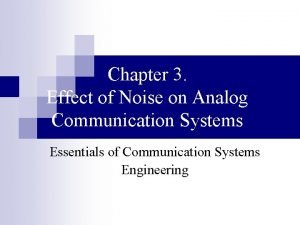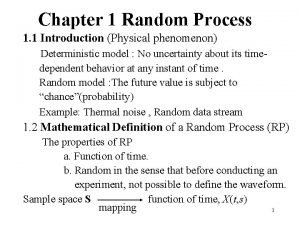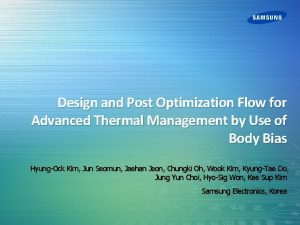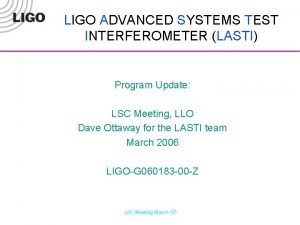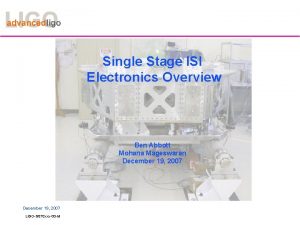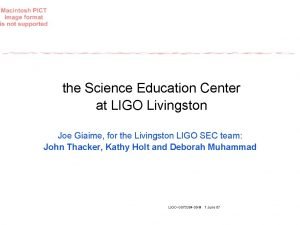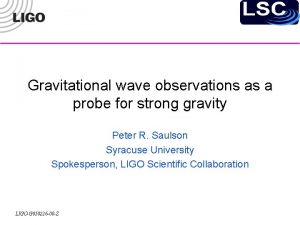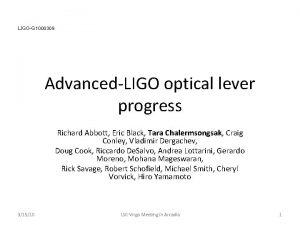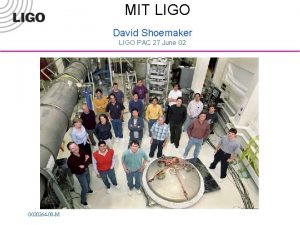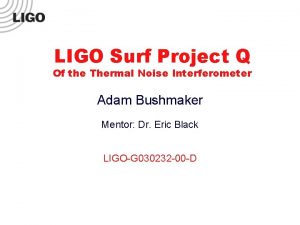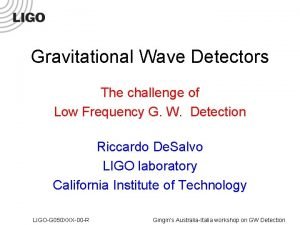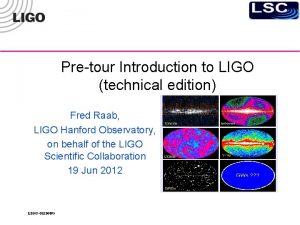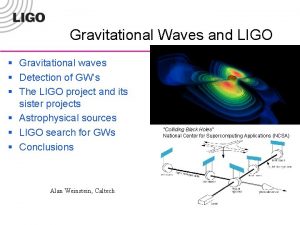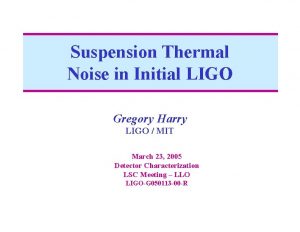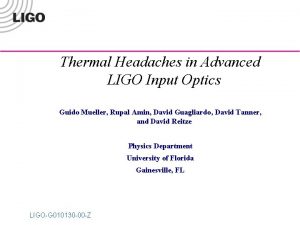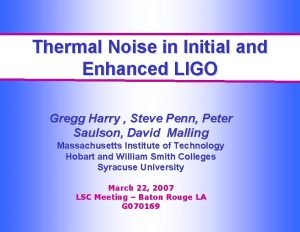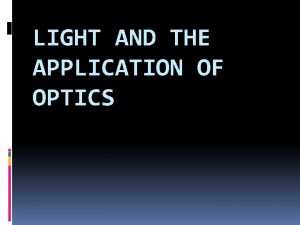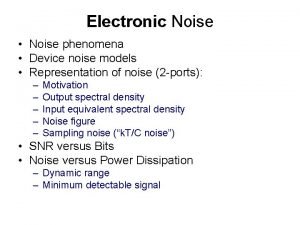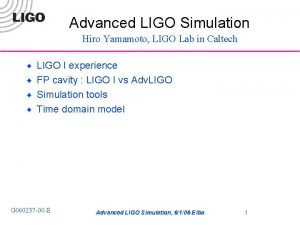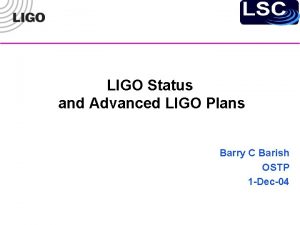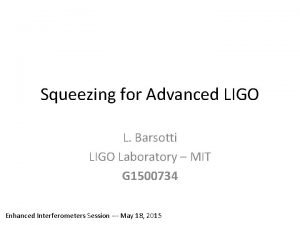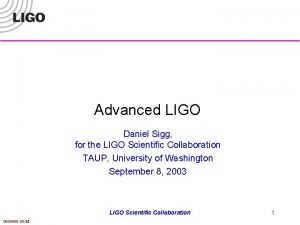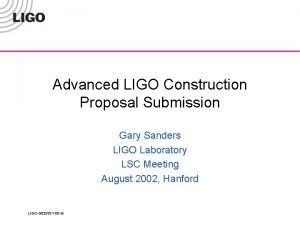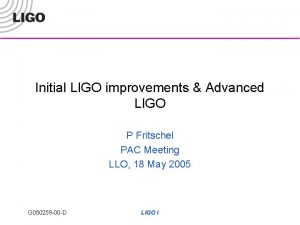Thermal Noise in Advanced LIGO Core Optics Gregory




















- Slides: 20

Thermal Noise in Advanced LIGO Core Optics Gregory Harry and COC Working Group Massachusetts Institute of Technology - Technical Plenary Session March 17 -20, 2003 LSC Meeting - Livingston, LA LIGO-G 030036 -00 -R 1

Outline • Sensitivity impact • Coating thermal noise • Relevance for material downselect • Silica annealing • Sapphire status • Modeling (analytical and FEA) • Direct thermal noise measurements LIGO-G 030036 -00 -R 2

Significance for sensitivity BNS Range 120 Mpc LIGO-G 030036 -00 -R BNS Range 200 Mpc 3

Coating thermal noise Status • Tantala/silica coating studied on silica - fcoat = 2. 8 +/- 0. 7 10 -4 (in modal Q measurements) - tantala dominates loss • Various other materials tried - niobia/silica, tantala/alumina, alumina/silica - none have consistently improved loss • Some work on sapphire substrates • Figure of merit developed d fcoat ( Ypar/Ysub + Ysub/Yperp) LIGO-G 030036 -00 -R 4

Coating thermal noise Recent results • Special coating developed at SMA/Virgo - tantala doped to reduce stress in coating - fcoat = 2. 8 10 -4 undoped tantala/silica - fcoat = 1. 8 +/- 0. 1 10 -4 MIT - fcoat = 1. 5 +/- 0. 7 10 -4 Glasgow - Young's modulus and optical absorption unchanged • Annealed alumina/silica sample measured - 2. 1 +/- 0. 6 10 -4 Glasgow - results pending at Syracuse • Coated sapphire next (Glasgow) LIGO-G 030036 -00 -R 5

Coating thermal noise Future plans • New material being developed at SMA/Virgo - index similar to tantala - Young's modulus similar to silica - working to get optical absorption down • Further work with doped tantala/silica • Correlate loss with coating stress • Explore effects of annealing • Measure coating thermal noise directly LIGO-G 030036 -00 -R 6

Material downselect Substrate loss BNS Range vs Q for Ycoat = 100 GPa and fcoat = 1 X 10 -5 LIGO-G 030036 -00 -R 7

Material downselect Coating loss BNS Range Ycoat = 70 GPa LIGO-G 030036 -00 -R Coating f BNS Range Ycoat = 200 GPa Coating f 8

Material downselect Coating Young's modulus BNS Range with fcoat = 1 X 10 -5 Coating Young's modulus LIGO-G 030036 -00 -R BNS Range with fcoat = 5 X 10 -5 Coating Young's modulus 9

Substrate thermal noise Silica status • Empirical understanding of silica loss is developing • Lossy surface layer limits Q • Annealing can dramatically increase Q • High Q in polished sample - 54 106 • High Q in flame drawn sample - 200 106 • See silica discussion Thursday afternoon LIGO-G 030036 -00 -R 10

Substrate thermal noise Sapphire status • • Thermal noise dominated by thermoelastic damping Modal Q's typically about 200 106 (S. Rowan, V. Mitrofanov, et al) • • Q's span 65 to 400 106 (K. Numata, P. Willems, et al) Low frequency dependence to loss unknown Anisotropy of loss not well understood See talk by G. Billingsley LIGO-G 030036 -00 -R 11

Substrate thermal noise Recent Q results on sapphire Two 40 kg samples measured for Q at Caltech by Phil Willems, 6 modes each - white (“good”) sapphire two degenerate modes show high Q Q 1 = 200 106 Sets limit on 6 Q 2 = 180 10 anisotropy of loss } - pink (“not”) sapphire shows high Q of 260 106 LIGO-G 030036 -00 -R 1/Q vs mode for both samples • Results fit two parameter model for single bulk f and surface (barrel) f very well 12

Other loss sources Bonding and charging • Silicate bonding to silica suspension • Bonded silica samples measured for Q at Glasgow and Syracuse using different geometries • Loss very high in bond region (f ~ 100 - 10 -2) • Calculations indicate will not effect thermal noise in advanced LIGO (Syracuse sample bonded in Glasgow) • Charging of optics • Modeling and Q measurements suggest will not limit thermal noise • Could be a source of other noise sources • May need more study LIGO-G 030036 -00 -R 13

Thermal noise modeling Analytical models we have • Non-modal, direct thermal noise calculation (Yu. Levin) Better Paradigm than modal Q for thermal noise • Finite sized, uncoated mirrors (Liu and Thorne, Bondu et al) • Infinite sized, coated mirrors (Nakagawa / Gretarsson et al) • Anisotropic coatings (assuming isotropic layers) fcoat+ = Ycoat / d (d 1 f 1 / Y 1 + d 2 f 2 / Y 2 ) • Thermoelastic damping in coatings (M. Fejer, S. Rowan) - sets limit on how low coating loss can be - creates preferential matching of coatings and substrates - see talk by Sheila Rowan later on Thursday LIGO-G 030036 -00 -R 14

Thermal noise modeling Models we need • Finite sized, coated mirrors N. Nakagawa is thinking about this problem FEA models indicate thermal noise goes down • Multiple coatings on substrate have secondary coating below first coating mechanical impedance matching one coating with low absorption, one with low loss no one is thinking about this problem • Anisotropic substrate used for sapphire, may not be necessary • Inhomogeneous loss distribution probably better done by finite element analysis (FEA) • (Coating thermal noise with Mexican hat beam) not strictly necessary LIGO-G 030036 -00 -R 15

Thermal noise modeling Finite element analysis Code we have OCEAN - coating, bonding, and surface loss Q (D. Crooks, et al) invaluable for coating and bonding loss efforts I-DEAS – inhomogeneous, anisotropic modal Q, and thermal noise (D. Coyne) good agreement with Nakagawa theory, being used for initial LIGO TAMA - inhomogeneous thermal noise (K. Numata, K. Yamamoto, et al) shows thermal noise lower than Nakagawa theory for finite mirrors What we need A sharable version of TAMA code Further development of most codes LIGO-G 030036 -00 -R 16

Direct measurement of thermal noise Thermal Noise Interferometer (Caltech) • Designed to measure thermal noise in silica and sapphire • Silica mirrors in place • Sapphire mirrors on hand • Measured noise close to Coating thermal noise tantala/silica coating thermal noise • Development ongoing • See TNI Technical Advisory Committee session from Tuesday LIGO-G 030036 -00 -R 17

Direct measurement of thermal noise University of Tokyo experiments • K. Numata thesis experiment • Measure Brownian and thermoelastic • BK 7 glass for Brownian, f independent • Ca. F 2 for thermoelastic, good agreement with theory • Trying to measure coating noise • K. Yamamoto thesis experiment • Examined nonhomogeneous loss • Good agreement with Levin LIGO-G 030036 -00 -R

Thermal noise prospectus What we need to do from here • Reduce coating thermal noise to acceptable level • Determine if high Q can be obtained in large, polished silica optics • Continue to study sapphire • Further development of theories to turn Q’s into thermal noise predictions • Confirm thermal noise predictions with direct measurements 19

Conclusions • Thermal noise is a crucial problem in advanced LIGO • Coating thermal noise reduction is proceeding • Material downselect depends on many factors • Silica and sapphire both are possible choices • Work remains on thermal noise modeling • Direct thermal noise measurements are beginning to provide input LIGO-G 030036 -00 -R 20
 Difference between ray optics and wave optics
Difference between ray optics and wave optics Venn diagram of geometric optics and physical optics
Venn diagram of geometric optics and physical optics Quantizing noise (quantization noise):
Quantizing noise (quantization noise): Rumus thermal noise
Rumus thermal noise White noise in analog communication
White noise in analog communication Thermal noise is a wide sense stationary process.
Thermal noise is a wide sense stationary process. Thermal noise
Thermal noise Thermal energy section 3
Thermal energy section 3 Thermal transfer vs direct thermal printing
Thermal transfer vs direct thermal printing Advanced thermal optimization lenovo
Advanced thermal optimization lenovo Ligo
Ligo Ben abbott ligo
Ben abbott ligo Ligo science education center
Ligo science education center Ligo science education center
Ligo science education center Ligo
Ligo Ligog
Ligog David shoemaker ligo
David shoemaker ligo Ligo surf
Ligo surf Ligo challenge xxx
Ligo challenge xxx Ligo
Ligo Ligo
Ligo




